PAOC Spotlights
Aerocene Soars at the 47th World Economic Forum Meeting
Climate-conscious sculptures influence world perspectives in Davos- Klosters, Switzerland.
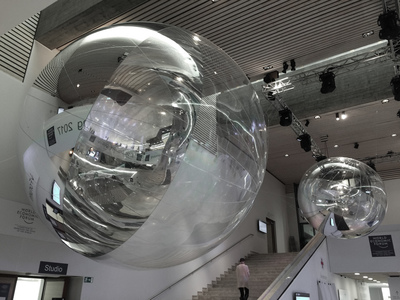
Aerocene, an artistic project developed by Tomás Saraceno and the Aerocene Foundation, has been collaborating with scientists in MIT's Department of Earth, Atmospheric and Planetary Sciences (EAPS) and was recently featured at the 2017 World Economic Forum (WEF) in Davos-Klosters, Switzerland. Aerocene is a series of air-fuelled sculptures that will achieve the longest, emission-free journey around the world, kept afloat only by the heat of the Sun and infrared radiation from the surface of Earth.
Since its establishment in 1971, the World Economic Forum has been committed to improving the state of the world. By engaging thousands of influential government officials, entrepreneurs, economists, researchers, policymakers, academics and artists, the event brings together thought leaders and strives to affect change. With a focus on the long-term, the WEF tackles challenges and opportunities that humanity faces from the perspective of “systems” — from issues of energy, environment, and natural resources to health, trade, and finance.
Art and culture at the forum help bridge the divide and bring context to these systems.
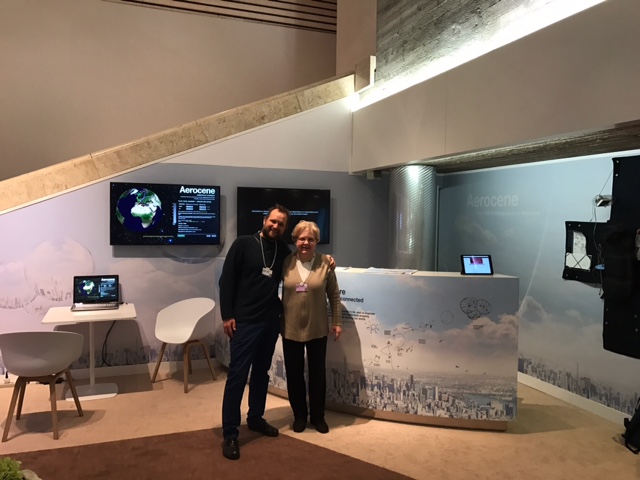
Artist Tomás Saraceno, a visiting artist with the MIT Center for Art, Science and Technology (CAST), was one of 40 individuals selected as a cultural leader for this year’s meeting. These artists helped to add dimension to the discussions and shape the global agenda by creating awe, challenging conventional thinking, and creating new narratives.
A goal of the WEF’s cultural leaders is to “humanize the statistics and provide radically different frameworks for understanding issues when engaging in panels and debates with global leaders on topics ranging from migration to gender parity and climate change.” Saraceno’s work with Aerocene is informed by art, architecture, natural sciences, astrophysics, engineering, and ongoing meteorological research collaboration with EAPS. A manifestation of this is floating sculptures, which explore new, sustainable ways of inhabiting and sensing the environment, as well as various online platforms, which engage the broader community.
“I think his [Saraceno’s] project was chosen because of the environmental impact,” MIT senior lecturer and meteorologist Lodovica Illari said about the presence of Aerocene at this year's WEF meeting. Illari accompanied Saraceno in Davos and explained the meteorological and atmospheric components of Aerocene to meeting attendees. “The WEF is getting very interested in climate and the environment … and I think Saraceno’s art was perceived as a way of interacting with Earth in a friendly way. There was a lot of emphasis on environmental issues and energy [at this meeting], in particular, and how to recover from the present climate crisis.”
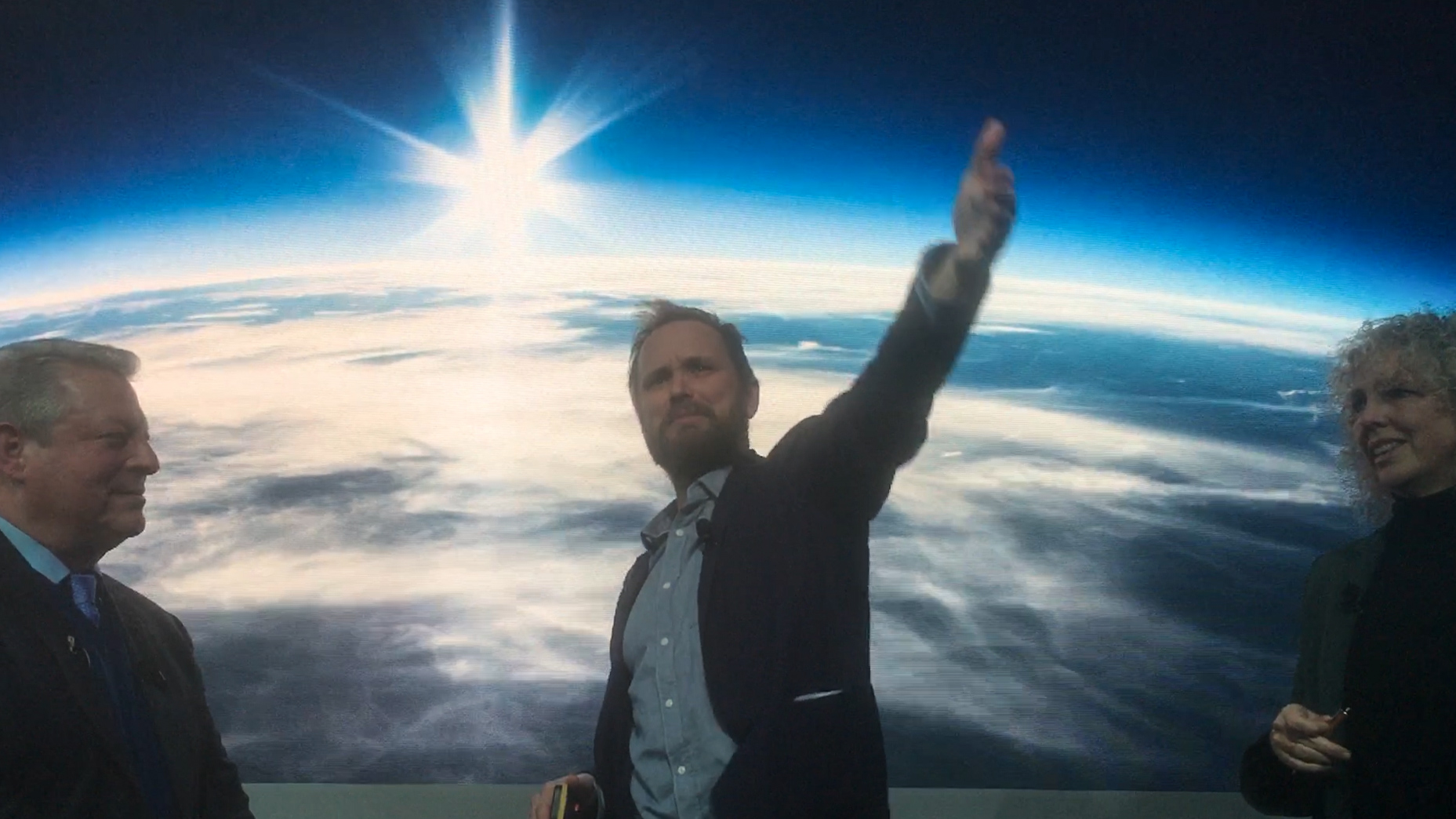 Aerocene — an imagined epoch beyond our current one, the Anthropocene, which is characterized by human influence over climate and the environment — envisages a fossil-free, zero-emissions world. Honing in on pollution from transportation, Aerocene sculptures employ atmospheric physics and meteorological principles to achieve emissions-free journeys. The inspiration for this grew out of the so-called Montgolfière Infrarouge: solar and infrared balloon flights developed by France’s space agency, CNES, where Saraceno was in residency. Aerocene was then realized using silver and transparent Mylar balloon-like sculptures, which could travel in the troposphere and stratosphere and be kept afloat by solar heat during the day and infrared radiation from Earth at night. Using climate and weather data analysis, MIT’s EAPS provided scientific and logistical context for the development of Saraceno’s new generation of sculptures that are not only able to fly, following the wind, but could potentially collect atmospheric measurements and monitor how Earth’s atmosphere is changing.
Aerocene — an imagined epoch beyond our current one, the Anthropocene, which is characterized by human influence over climate and the environment — envisages a fossil-free, zero-emissions world. Honing in on pollution from transportation, Aerocene sculptures employ atmospheric physics and meteorological principles to achieve emissions-free journeys. The inspiration for this grew out of the so-called Montgolfière Infrarouge: solar and infrared balloon flights developed by France’s space agency, CNES, where Saraceno was in residency. Aerocene was then realized using silver and transparent Mylar balloon-like sculptures, which could travel in the troposphere and stratosphere and be kept afloat by solar heat during the day and infrared radiation from Earth at night. Using climate and weather data analysis, MIT’s EAPS provided scientific and logistical context for the development of Saraceno’s new generation of sculptures that are not only able to fly, following the wind, but could potentially collect atmospheric measurements and monitor how Earth’s atmosphere is changing.
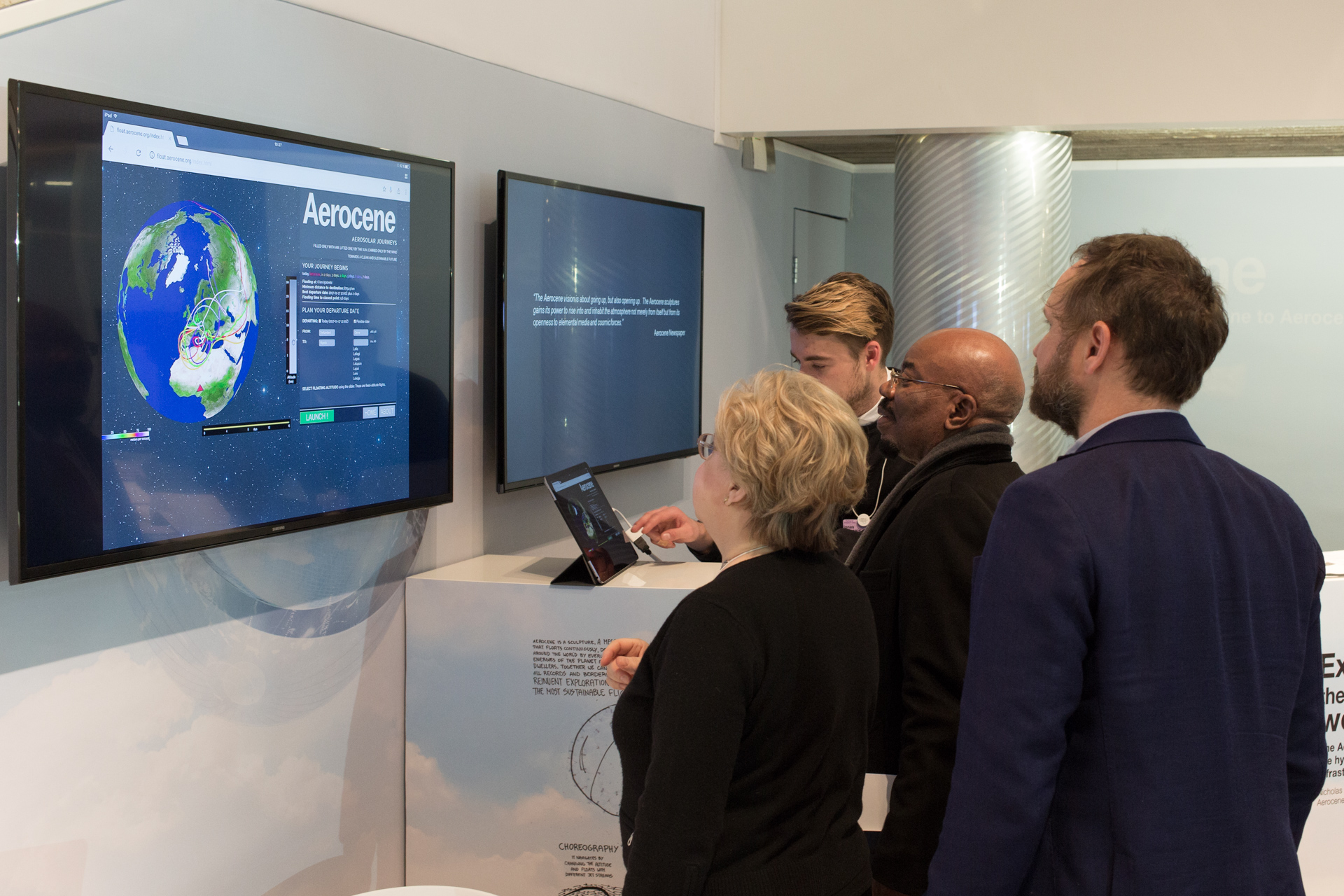
A large installation in the Congress Centre in Davos showcased the joint work to make the dream of “aerosolar infrastructure” possible. Two large balloon structures dangled from the atrium ceiling, on display for forum attendees to admire. Drawn in by the sculptures and Saraceno’s passion for sustainability, guests, eager to learn more, approached Illari, who spoke in depth on the science behind the Aerocene project. Using a touchscreen with a globe projection, Illari explained how these balloons were able to float in the air, following trajectories dictated by atmospheric conditions and wind currents. The software, visualizations, and interface for the project's trajectories display were developed at MIT by Illari, professor of oceanography Glenn Flierl, and research associate Bill McKenna, with the support of MIT CAST. Additionally, an interactive online simulation allowed guests to virtually launch an Aerocene sculpture and explore how evolving wind patterns affect where the structure goes, using wind forecast data from the U.S. National Oceanic and Atmospheric Association Global Forecast System. The visitors were often surprised to see how far one could travel with these floating sculptures. Exploring this, guests initiated virtual journeys at various altitudes, locations and on different days, with the goal of reaching a particular destination.
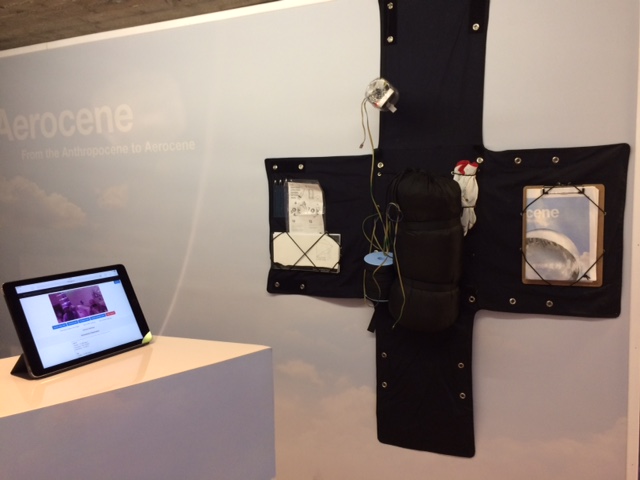
Also in the exhibit was "Aerocene Explorer," a backpack-sized, tethered-flight starter balloon kit, which allows users to explore the sky, take aerial photos and video, and collect atmospheric data using non-intrusive, emissions-free scientific tools that measure air quality, temperature, humidity, and pressure. Saraceno hopes to engage Explorer users all around world and create a public environmental bank with the collected data.
Saraceno also participated in a discussion that envisioned a world “Beyond the Anthropocene.” Moderated by Jennifer Morgan, executive director of Greenpeace International, the talks explored what it will take to return to a stable and resilient Earth system on a human-dominated planet. Former U.S. Vice President Al Gore provided the opening remarks before opening up the floor to presentations by Saraceno and environmental scientist Johan Rockström, executive director of the Stockholm Resilience Centre. Rockström’s scientific talk centered on how CO2 warmed the planet and how we can recover from it. This was followed by a futuristic and inspiring talk given by Saraceno, who described how to become “aerosolar” in the new Aerocene epoch.
The mission of Aerocene reminds us that no matter what walk of life you come from, we’re all in the same boat when it comes to the climate and global emissions, and each of us is responsible and can make a difference. “Aerocene holds a message of simplicity, creativity, and cooperation for a world of tumultuous geopolitical relations, reminding us of our symbiotic relationship with the Earth and all its species,” Saraceno said.
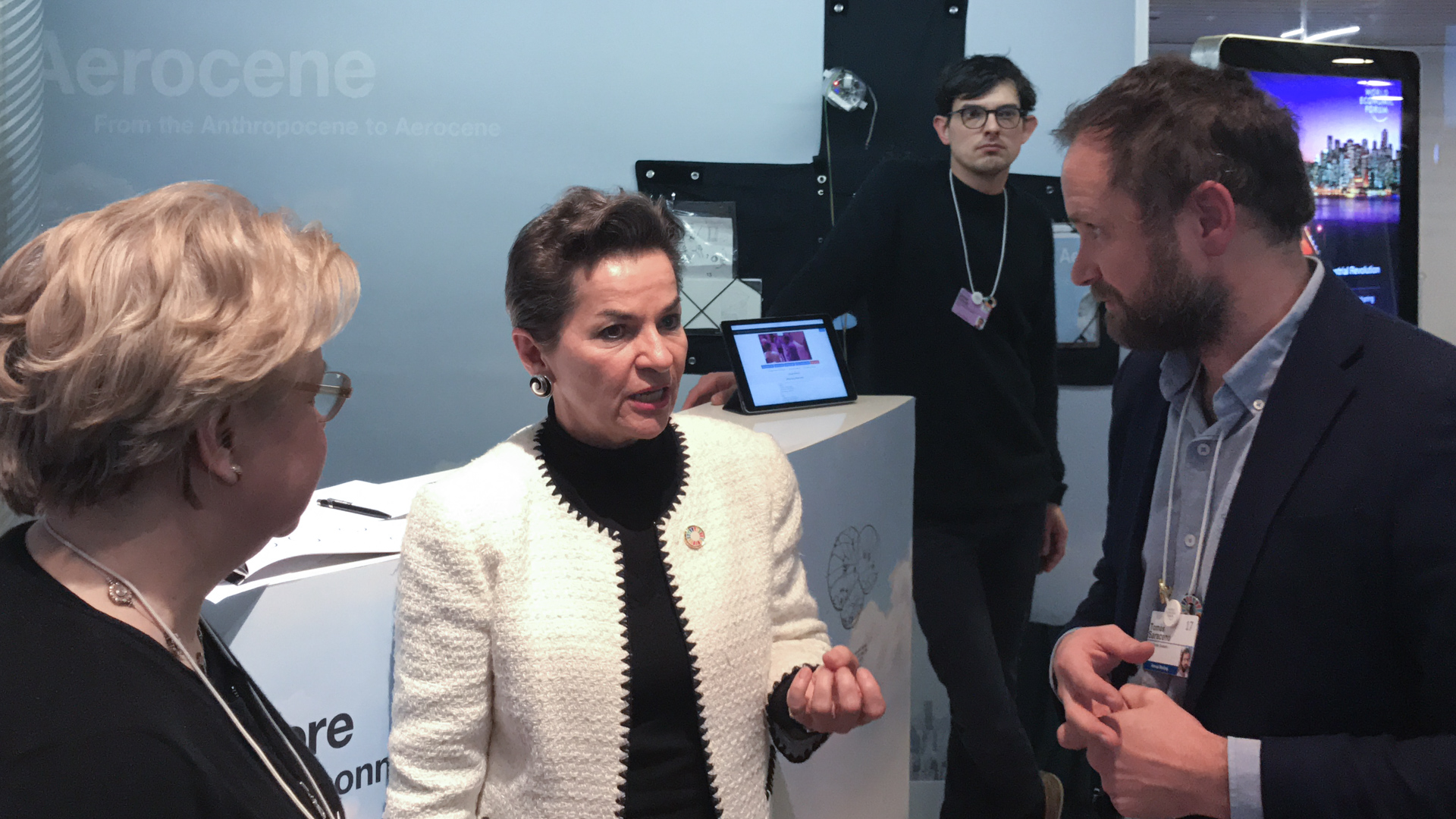 Many forum participants, entrepreneurs from the world of energy, technology, and education were attracted to the Aerocene booth by the beauty of the two floating spheres. “The trajectory interface created at MIT made the Aerocene idea look real,” Illari remarked. “It showed that it is possible to float in the air for many miles without any fossil fuel or noble gases, just by the power of the wind and the sun and Earth’s radiation.”
Many forum participants, entrepreneurs from the world of energy, technology, and education were attracted to the Aerocene booth by the beauty of the two floating spheres. “The trajectory interface created at MIT made the Aerocene idea look real,” Illari remarked. “It showed that it is possible to float in the air for many miles without any fossil fuel or noble gases, just by the power of the wind and the sun and Earth’s radiation.”
Christiana Figueres, executive secretary of the UN Framework Convention on Climate Change and a leading negotiator of the international Paris Agreement in 2016, visited the installation and immediately became an enthusiastic supporter of the Aerocene project. “At this stage of the climate crisis, we need to be able to think outside the box and dare to imagine different ways of living and moving on Earth,” Illari recalled. “It is not enough to carry on with business as usual.” But the work of climate scientists and artists is always evolving and adapting, and according to Illari, the project continues to aspire for new heights: “Aerocene was one of the most daring projects at Davos this year!”
Lodovica Illari received support from the NSF FESD 'Ozone and Climate Project' for participation in Aerocene.
***
Photos: Aerocene, at the World Economic Forum Annual Meeting 2017, Davos, Switzerland. Together with Lodovica Illari, MIT EAPS, and Nick Shapiro, PublicLab. The project is developed by Aerocene Foundation, www.aerocene.org.(Images: © Photography by Studio Tomás Saraceno, 2017 and Lodovica Illari)
More about the Aerocene Project, MIT and the World Economic Forum Meeting 2017:
Behind the Artwork: Tomas Saraceno's Aerocene Project
At COP21, Finding Hope for Climate in the Aerocene